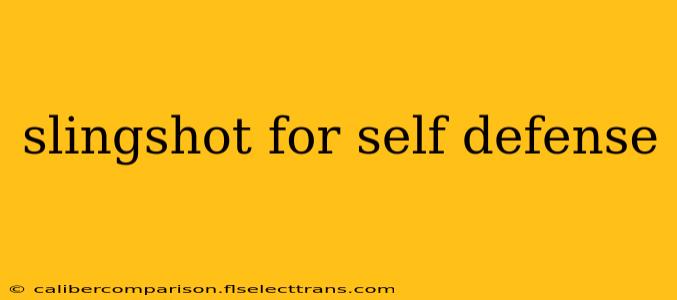Slingshots, often associated with childhood fun, possess surprising potential for self-defense in specific situations. However, it's crucial to understand the legal ramifications and limitations before considering a slingshot for self-protection. This guide explores the capabilities, limitations, and legal aspects of using a slingshot for self-defense.
The Pros and Cons of Using a Slingshot for Self-Defense
Advantages:
- Concealability: Many slingshots are compact and easily concealed, unlike larger self-defense weapons.
- Accessibility: Slingshots are relatively inexpensive and readily available, requiring no special permits in most jurisdictions (though laws vary widely, see below).
- Less-Lethal Option: While capable of causing injury, slingshots offer a less-lethal alternative to firearms or other more dangerous weapons, potentially reducing the risk of serious harm. This is highly dependent on the projectile used and the skill of the user.
- Ease of Use: With minimal practice, anyone can achieve a degree of proficiency with a slingshot.
Disadvantages:
- Limited Range and Accuracy: Compared to firearms, slingshots have significantly shorter range and accuracy. Effective self-defense requires considerable skill and practice.
- Dependence on Ammunition: The effectiveness hinges on the availability and appropriate selection of ammunition (e.g., steel ball bearings, smooth stones). Improper ammunition choices can significantly reduce effectiveness or increase the risk of legal repercussions.
- Legal Restrictions: Laws governing slingshot ownership and use vary considerably by location. Possession or use might be illegal or heavily restricted in certain areas, even for self-defense.
- Potential for Misuse and Injury: Even with proper training, there’s a risk of accidental injury to the user or bystanders. The impact of a well-aimed shot can be quite substantial.
Legal Considerations: A Critical Factor
The legality of using a slingshot for self-defense is highly dependent on your location. Laws differ dramatically between states, countries, and even municipalities. Some jurisdictions may completely prohibit the ownership or use of slingshots, while others might allow them under specific circumstances (e.g., for hunting small game). Before even considering using a slingshot for self-defense, research the specific laws in your area. Failure to comply with local ordinances can result in serious legal consequences, including fines or imprisonment. Consult local law enforcement or a legal professional to clarify the relevant regulations in your jurisdiction.
Ammunition Selection and Safety Precautions
The choice of ammunition greatly impacts both the effectiveness and the legal implications of using a slingshot for self-defense. Steel ball bearings are a common choice, but their use might be restricted or prohibited in some areas. The use of projectiles designed to cause excessive harm could lead to aggravated assault charges.
Always prioritize safety:
- Proper training: Practice extensively in a safe environment to develop accuracy and control.
- Awareness of surroundings: Be mindful of potential bystanders and avoid aiming near anything that could cause collateral damage.
- Storage: Store slingshots and ammunition securely and out of reach of children.
Alternatives to Slingshots for Self-Defense
Consider exploring alternative self-defense options that might be legal, more effective, and safer in your jurisdiction. These could include:
- Self-defense classes: Learning proper self-defense techniques is arguably the best way to protect yourself.
- Pepper spray: A readily available and relatively non-lethal option, but laws vary regarding its use.
- Personal alarms: These can alert others to a situation and potentially deter attackers.
Conclusion: Weighing the Risks and Benefits
While slingshots can offer a degree of self-defense capability, their limitations and legal uncertainties make them a questionable choice for many. The potential for injury, both to the user and bystanders, along with the considerable legal risks, necessitates a careful evaluation of the advantages and disadvantages before considering this option. Thorough research of local laws and exploration of alternative, safer self-defense methods are strongly recommended. Remember, the safest approach is often to avoid dangerous confrontations altogether and prioritize your personal safety.

